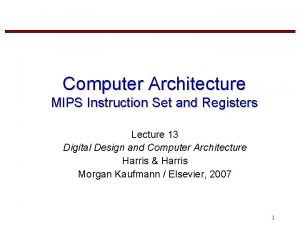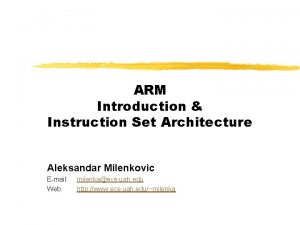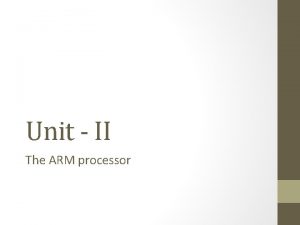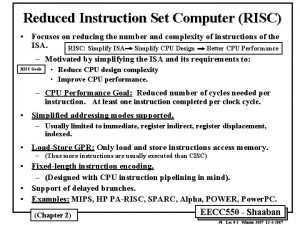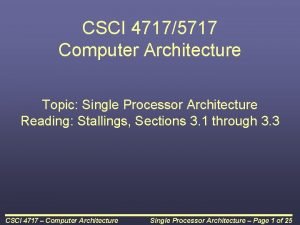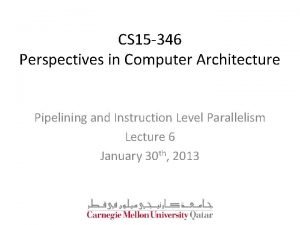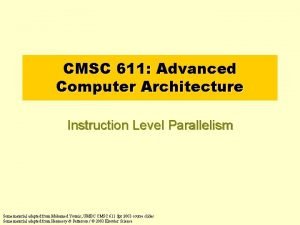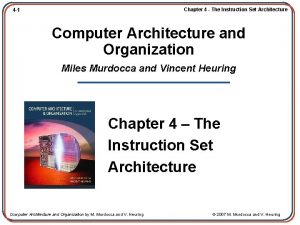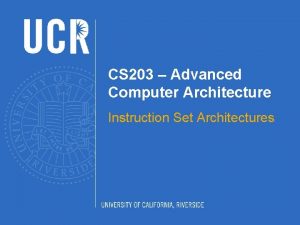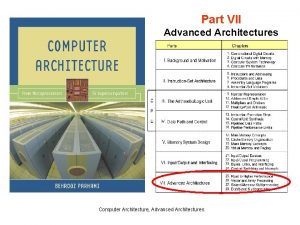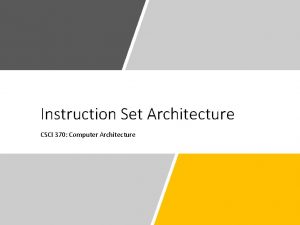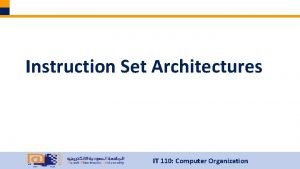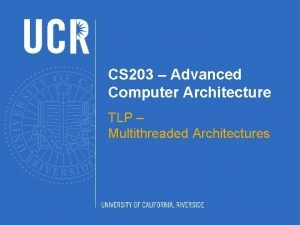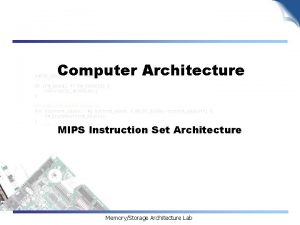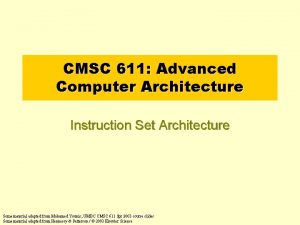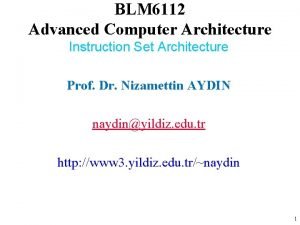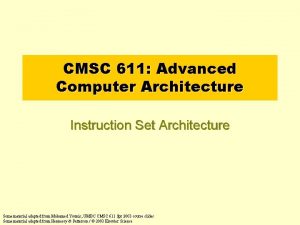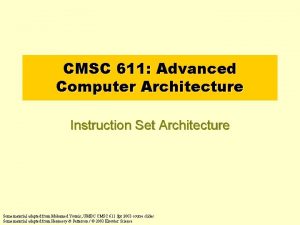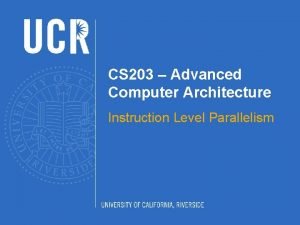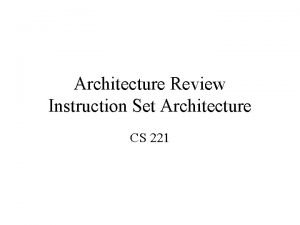CS 203 Advanced Computer Architecture Instruction Set Architectures





![Addressing Modes MODE EXAMPLE MEANING REGISTER ADD R 4, R 3 reg[R 4] <- Addressing Modes MODE EXAMPLE MEANING REGISTER ADD R 4, R 3 reg[R 4] <-](https://slidetodoc.com/presentation_image_h2/cb11da80925a5726eb0c8128014533ab/image-6.jpg)














- Slides: 20

CS 203 – Advanced Computer Architecture Instruction Set Architectures

Instruction set architecture (ISA) The ISA is the interface between software and hardware Design objectives Functionality and flexibility for OS and compilers Implementation efficiency in available technology Backward compatibility ISAs are typically designed to last through trends of changes in usage and technology As time goes by they tend to grow 2

Instruction types and opcodes The opcode of an instruction indicates the operation to perform Four classes of instructions are considered: Integer arithmetic/logic instructions Add, sub, mult Addu, subu, multu Or, and, nor, nand Floating point instructions Fadd, fmul, fdiv Complex arithmetic Memory transfer instructions Loads and stores Test and set, and swap May apply to various operand sizes Control instructions Branches are conditional Condition may be condition bits (zcvxn) Condition may test the value of a register (set by slt instruction) Condition may be computed in the branch instruction itself Jumps are unconditional with absolute address or address in register Jal (jump and link) needed for procedures 3

Operands inside the CPU Include: accumulators, evaluation stacks, registers, and immediate values Accumulators ADDA <mem_address> MOVA <mem_address> Stack PUSH <mem_address> ADD POP <mem_address> Registers LW R 1, <memory-address> SW R 1, <memory_address> ADD R 2, <memory_address> ADD R 1, R 2, R 4 LOAD/STORE ISAs Management by the compiler: register spill/fill Immediate ADDI R 1, R 2, #5 4

Memory Operands Operand alignment Byte-addressable machines Operands of size s must be stored at an address that is multiples of s Bytes are always aligned Half words (16 bits) aligned at 0, 2, 4, 6 Words (32 bits) are aligned at 0, 4, 8, 12, 16, . . Double words (64 bits) are aligned at 0, 8, 16, . . . Compiler is responsible for aligning operands. Hardware checks and traps if misaligned Opcode indicates size (also: tags in memory) Little vs. Big endian: msb is stored at address xxxxxx 00 Little endian: lsb is stored at address xxxxxx 00 Portability problems, configurable endianness 5
![Addressing Modes MODE EXAMPLE MEANING REGISTER ADD R 4 R 3 regR 4 Addressing Modes MODE EXAMPLE MEANING REGISTER ADD R 4, R 3 reg[R 4] <-](https://slidetodoc.com/presentation_image_h2/cb11da80925a5726eb0c8128014533ab/image-6.jpg)
Addressing Modes MODE EXAMPLE MEANING REGISTER ADD R 4, R 3 reg[R 4] <- reg[R 4] +reg[R 3] IMMEDIATE ADD R 4, #3 reg[R 4] <- reg[R 4] + 3 DISPLACEMENT ADD R 4, 100(R 1) reg[R 4] <- reg[R 4] + Mem[100 + reg[R 1]] REGISTER INDIRECT ADD R 4, (R 1) reg[R 4] <- reg[R 4] + Mem[reg[R 1]] INDEXED ADD R 3, (R 1+R 2) reg[R 3] <- reg[R 3] + Mem[reg[R 1] + reg[R 2]] DIRECT OR ABSOLUTE ADD R 1, (1001) reg[R 1] <- reg[R 1] + Mem[1001] MEMORY INDIRECT ADD R 1, @R 3 reg[R 1] <- reg[R 1] + Mem[Reg[3]]] POST INCREMENT ADD R 1, (R 2)+ ADD R 1, (R 2) then R 2 <- R 2+d PREDECREMENT ADD R 1, -(R 2) R 2 <- R 2 -d then ADD R 1, (R 2) PC-RELATIVE BEZ R 1, 100 if R 1==0, PC <- PC+100 PC-RELATIVE JUMP 200 Concatenate bits of PC and offset 6

Control flow Types conditional branch: beq r 1, r 2, label jump: jum label procedure call: call label procedure return: return, or, return r 4 Conditional branch how to specify the condition many options how to specify the address most common: PC relative 7

Branch condition Condition codes: Z, N, V, C (zero, negative, overflow, carry) set after any arithmetic or logic operation (ALU) add r 1, r 2, r 3 bc label (branch on carry) Compare and branch beq r 1, r 2, label (MIPS) Condition register use GPR cmp r 1, r 2, r 3 bnz r 1, label use condition register cmp c 2, r 1, r 3 (Power. PC) 8

Instruction format Options Size fixed, variable, hybrid Field locations fixed field: typical of RISC multiple fields and/or modifiers Theoretically any encoding will do. However, watch for code size and decoding complexity. Decoding is simplified if instruction format is highly predictable 9

Exceptions, Traps And Interrupts Exceptions are rare events triggered by the hardware and forcing the processor to execute a handler Includes traps and interrupts Examples: I/O device interrupts Operating system calls Instruction tracing and breakpoints Integer or floating-point arithmetic exceptions Page faults Misaligned memory accesses Memory protection violations Undefined instructions Hardware failure/alarms Power failures Precise exceptions: Synchronized with an instruction Exceptions appear in instruction sequence and only the first exception in the pipeline will be architecturally visible Save process state at faulting instruction, resume execution after handler Often difficult in architectures where multiple instructions execute 10

RISC versus CISC: Complex Inst. Set Computers very powerful instructions that model HLL constructs micro-programmed control unit technology constraints: minimize program footprint in memory examples: DEC VAX, Intel x 86, IBM 11

RISC versus CISC RISC: Reduced … misnamed: Simplified load/store ISA, only register operands hardwired control unit: fixed field decoding designed with compiler in mind … examples: MIPS, Sparc, Alpha, Power. PC 12

RISC vs. CISC Instruction Set Design The historical background: In first 25 years (1945 -70) performance came from both technology and design. Design constraints: small and slow memories: compact programs are fast. small no. of registers: memory operands. attempts to bridge the semantic gap: model high level language features in instructions. no need for portability: same vendor application, OS and hardware. backward compatibility: every new ISA must carry the good and bad of all past ones. Result: powerful and complex instructions that are rarely used. 13

Frequency - integer CISC instructions Rank Instruction Avg. % executed 1 load 22% 2 conditional branch 20% 3 compare 16% 4 store 12% 5 add 8% 6 and 6% 7 sub 5% 8 move register 4% 9 call 1% 10 return 1% Total 96% x 86 integer code execution Simple instructions dominate, make the common case fast 14

RISC vs. CISC Instruction Set Design Emergence of RISC Very large scale integration (processor on a chip): silicon real-estate at a premium. Micro-store occupies about 70% of chip area: replace micro-store with registers ==> load/store ISA. Increased difference between CPU and memory speeds. Complex instructions were not used by new compilers. Software changes: reduced reliance on assembly programming, new ISA can be introduced standardized vendor independent OS (Unix) became very popular in some market segments (academia and research) – need for portability Early RISC projects: IBM 801 (America), Berkeley SPUR, RISC I and RISC II and Stanford MIPS. 15

RISC v/s CISC ISAs Feature CISC RISC Inst. Length Variable Fixed, one word Inst. Formats Multiple Fixed-field decoding Memory operands Multiple Load/store arch. Addressing mode Multiple, indirect One Inst. Complexity >1 cycle/inst Control unit 1 cycle/inst μ-programmed hardwired 16

MIPS Instruction Layout 17

Compiler Optimizations 18

Impact of optimizations lucas: Fortran 90. Performs the Lucas -Lehmer test to check primality of Mersenne numbers 2^p-1, using arbitrary-precision (array-integer) arithmetic. mcf: C. Large-scale minimum-cost flow problem that we solve with a network simplex algorithm 19

And in conclusion … Modern ISA regularity & simplicity more important than power and flexibility parallelism (non obstruction of) is key beware of additions (to ISAs)! there are no subtractions Compiler is the customer no more handwritten assembly code Read Appendix A 20
 Isa in computer architecture
Isa in computer architecture Instruction set architecture in computer organization
Instruction set architecture in computer organization Skipcond
Skipcond Mips instruction set architecture
Mips instruction set architecture Arm instruction set architecture
Arm instruction set architecture Which instruction set architecture is used in beaglebone?
Which instruction set architecture is used in beaglebone? Instruction set architecture
Instruction set architecture 430830
430830 Classifying instruction set architecture
Classifying instruction set architecture Total set awareness set consideration set
Total set awareness set consideration set Training set validation set test set
Training set validation set test set Little man computer code
Little man computer code Cisc complex instruction set computer
Cisc complex instruction set computer Risc instruction set example
Risc instruction set example Instruction format in computer architecture
Instruction format in computer architecture Instruction cycle in computer architecture
Instruction cycle in computer architecture Pipelining in computer architecture examples
Pipelining in computer architecture examples Ilp computer architecture
Ilp computer architecture Arc instruction set
Arc instruction set Review of fundamentals of cpu
Review of fundamentals of cpu Bus design in computer architecture
Bus design in computer architecture



